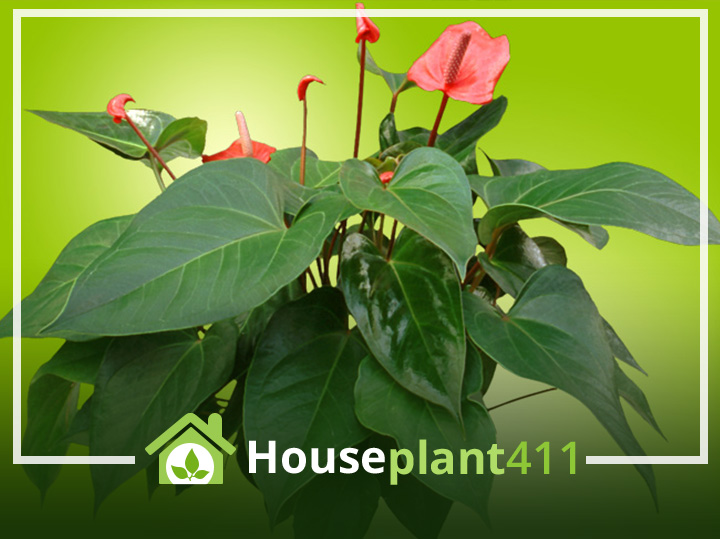About
Anthurium is a genus of flowering plants and part of the Araceae family. Some other familiar houseplants that belong to the Aracaea family are the dieffenbachia, calla lily, monstera, and caladium. All plants in the Aracaea family are poisonous and very toxic to small children and pets. Popular names for an anthurium are Flamingo Flower, Flamingo Plant, Laceleaf, and Boy Flower. The last name refers to the physical appearance of the plant. These plants were originally found growing in parts of the Caribbean and from northern Mexico to northern Argentina. Today, anthuriums not only grow outdoors in shady spots where the climate is always mild; but they have also become very popular, flowering, indoor plants.
Anthurium Plant Description
This easy-care houseplant produces beautiful, long-lasting, waxy, heart- shaped “flowers” which are really modified leaves called “spathes” throughout the year. The exotic looking anthurium flowers come in vibrant red, light pink, dark pink, white, purple, orange, green, and new varieties are bi-colored. There are even light blue and dark blue anthurium flowers. The plant usually blooms for a few months and then rests for a few months before blooming again. Some anthuriums have leaves that are as spectacular looking as flowers.
Anthurium Varieties
Flamingo Flower (Anthurium andreanum), the most popular variety sold, is easily recognized by its bright red flowers.
Black Anthurium(Anthurium watermaliense) has deep purple flowers that are so dark they almost look black.
Some anthuriums have leaves that are as spectacular looking as flowers.
Velvet Cardboard (Anthurium Clarinervium) has large, heart- shaped, green leaves with thick white veins.
Queen Anthurium has velvety, dark green, large, long, leaves with silvery, white veins.
Other anthurium plants with beautiful leaves include: Anthurium Magnificum, Anthurium Crystallinum, Big Red Bird Anthurium, and Anthurium Pedatoradiatum.
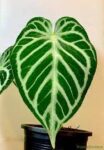
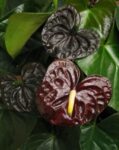
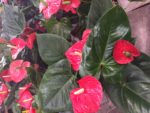

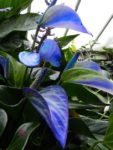
Velvet Cardboard Black Anthurium Flamingo Flower A. Magnificum Blue Anthurium
Quick Care Tips
Like to be warm, minimum temperature of 60°F in winter
Easily propagated by plant division
Bright light but no direct sun
Yellow leaves indicates over watering – Brown leaf tips indicate too little water
Likes high humidity
Plant Care
Light
How much light for an anthurium: Provide as much bright, indirect light as possible, but no direct sun. If there is insufficient light, an anthurium produces fewer flowers and becomes thin and straggly as stems stretch toward the light.
Water
How to water an anthurium: Water well and then allow the top few inches of soil to dry out before watering again. Over-watering causes yellow leaf tips and under- watering causes brown leaf tips.
Fertilizer
How to fertilize an anthurium: Feed monthly in the spring and summer with a balanced fertilizer, or one slightly high in nitrogen, diluted to 1/2 the recommended strength. Do not fertilize if the plant is not actively growing.
Temperature
What is the best temperature for an anthurium: 75°F-85°F (23.9°C-29.4°C) during the day and about 10° cooler at night are ideal. Temperatures below 60°F (15.6°C) slow leaf and flower growth.
Humidity
An anthurium grows best in high humidity.
Flowering
How to get an anthurium plant to flower: Anthuriums flower off and on throughout the year, usually producing buds every 3-4 months. The plant flowers more if, in late winter and early spring, it has a 6-8 week rest period. During this time, place the plant in a cooler, darker area, do not feed, and allow the soil to get a bit drier before watering. After this rest period, move the plant back to a bright, warm location and begin fertilizing again. Quickly remove anthurium flowers once they start fading.
Pests
Anthurium plant pests: Mealy bugs, scale, aphids, and thrip can be a problem; and the new, tender growth is especially vulnerable. Examine your plants carefully every time you water. Spray with the non-toxic “Green Solution” (recipe in Glossary) if you notice plant pests. You can read morehow to identify and treat all of theses plant pests in the Glossary of the website.
Diseases
Anthurium plant diseases: Because of the high humidity and warmth the plant requires, fungal and bacterial plant diseases are a problem. Keeping the plant leaves dry and providing good air circulation helps prevent plant diseases.
Soil
Best soil for an anthurium plant: Use a rich, organic, loose potting soil that contains some mulch and sphagnum moss. A quick draining soil helps prevent root rot.
Pot Size
Pot size for an anthurium plant: An anthurium likes to be root-bound, so always wait until the roots have filed the current container before repotting. The new container should be only one sizes larger and must have drip holes in the bottom so excess water can escape.
Pruning
How to prune an anthurium: Remove faded or dead flowers and leaves as soon as they appear.
Propagation
How to propagate an anthurium: Best propagated using stem cuttings and offsets. You can read more about both of these propagation techniques in the Glossary of the website.
Resting Period
Does an anthurium plant need a resting period: An anthurium plant needs a 6-8 weeks rest when it is dormant during the late winter and early spring. Water less, do not fertilize, and keep the plant out of bright light during this time. After the resting period, resume your regular care routine. Lower temperatures, less light, and drier soil during the winter help an anthurium produce more flowers in the spring and summer.
Clean Air Plant
Is an anthurium a clean air plant: An anthurium removes ammonia, formaldehyde, and xylene from the air.
Poisonous Plant Info
An anthurium is a very poisonous plant and toxic to cats, dogs, and children. It has a #3 toxicity level which means it should be kept far out of reach.
FAQ
Give your anthurium plants a six-week rest during the winter. Move them to an area that gets less light and lower temperatures. Reduce your watering. This should help them produce more flowers the following year.
Flowers from anthurium plants make excellent cut flowers. Anthurium blooms can be used in arrangements or alone in a vase of water. They stay looking good for quite a long time.
Yellow leaves can be an indication of over-watering, over-fertilizing, or having the plants in a room that is too cold.
Anthurium plants are very poisonous. If ingested the plant cause severe stomach distress, the smaller the victim the more serious the consequences. Anthurium plants can also cause painful skin irritations.

